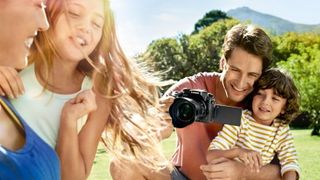Scared off by 4K? Panasonic busts some myths
Why grabbing 8Mp stills from 4K video is not just a novelty, and why 4K video gives you much more freedom
Panasonic uses professional 'ambassadors' to promote the technology, and it looks like they're using these stills professionally for themselves – is that right?
Absolutely right. Our first ambassador, Hugh Hastings, came to Panasonic last year – he's an ex Chelsea Football photographer, and he's now the Archive Manager for Chelsea Football Club and a freelance photographer – he said, 'I've just swapped my old kit for your kit, and I want to talk to you about it.' Since then, we've grown from Hugh to 20 photographers shooting portraits, sports, landscapes – we've done work with Charlie Waite this year and we hope to do more – and we've got Stuart Morgan on our stand, a freelance videographer who's done work for Top Gear using the GH4. Ross Grieve is an award-winning portrait photographer, and he and [sports photographer] Ian Cook use Nikon DSLRs but also Lumix G cameras in a way that they can't use their Nikons.


So you're talking about shooting 4K specifically for stills, and not for the video itself.
Each frame of video is a full 8Mp frame of detail on its own. If you've got the right shutter speed and the right ISO and the right lighting, you can capture motion. You take pin-point accurate stills from video in the cameras, so if you're on holiday and jumping into the pool you're able to record the whole thing from the start – from arriving at the pool, getting ready, jumping in, jumping out, and the reaction afterwards. Then you can play it back in the camera, and actually go through frame by frame by frame and pick the best shots out.
It sounds like you're going to need a lot of storage?
People are saying, 'don't I need a fast card, how much memory do I need on an SD card for 4K?' – well, yes, the more space you've got the more you can put on there. But you may not need all that video – so you can delete it, but keep the stills.

There's this other idea that maybe you've got 4K footage shot from a static viewpoint, but then you can crop in, do selective panning and motion effects – and even in that cropped section, you still get full HD quality.
Get daily insight, inspiration and deals in your inbox
Get the hottest deals available in your inbox plus news, reviews, opinion, analysis and more from the TechRadar team.
That's a good point. If you zoom in 200% in post editing, you have full HD but with 4:4:4 and 8-bit or 10-bit output, which is one of the highest levels of full HD output you can get. We've got two or three consumer products now where you can make beyond broadcast quality video. Stuart Morgan has made videos for Skoda, Top Gear and so on, where he's been making his own scaffolding, bolting the cameras on to the sides of cars so that in post editing you can then do the cropping and the panning and make a static image look like it's moving.
So if you're photographing wildlife, for example, you can't tell the animal where to go and how fast, so this ability to crop and pan later could be useful?
That's a really good point, actually. Yes, sometimes subjects are unpredictable.
Any final words for video, and 4K, sceptics?
Sometimes there's that fear, isn't there, of that red button on a camera? People say, 'I know it does video, but I'm not going to use it'. We're not forcing the 4K message – the 4K message is very strong and we're showing people just what it's capable of.
Most Popular



